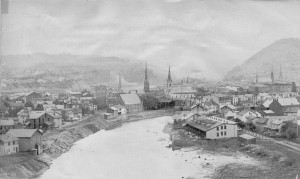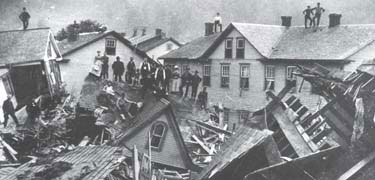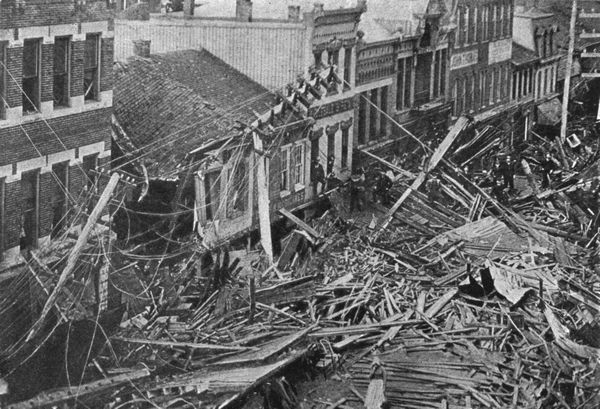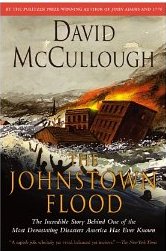Book Review: The Johnstown Flood
Why do I like stories about disasters and tragedy? The Titanic. The Galveston Hurricane. The Holocaust. These are all topics I find myself interested in, mainly because, though some people certainly die, I like the stories of everyday people who overcome incredible odds. That’s the crux of every good novel, if you think about it. Plus these are real people—nobody made them up—and their stories of courage and tragedy haunt me.
The Johnstown Flood of May 31, 1889, is one of those stories that grabbed ahold of me and wouldn’t let go until I’d finished reading David McCullough’s fine, engaging book. I wanted to know how two thousand people could just die because of a broken dam. And how could a dam fall into such disrepair and fail? Didn’t the people in the valley below realize they were living in a major flood zone? Didn’t anyone warn them? Why would anyone live in such a place? McCullough painstakingly answers these questions.
 Bottom line? A lot of rich people at the top of the hill (the South Fork Fishing and Hunting Club), including big names like Andrew Carnegie, wanted a relaxing place to hang out away from the city. On the land they bought was an old earthen dam once owned by the government, but the government had forgotten about it. To their credit, these rich folks did some work to keep the dam in decent condition, but in the end their efforts were minimal at best and slipshod at worst. In the end they didn’t maintain it properly, and they blamed the government when the dam failed. The government then blamed the rich people. So in the end nobody took responsibility, if you can imagine that. Nowadays you’re talking about a billion-dollar class-action suit over something like this. You simply can’t have a dam holding back thousands of gallons of water, endangering lives, and in the end killing so many helpless people.
Bottom line? A lot of rich people at the top of the hill (the South Fork Fishing and Hunting Club), including big names like Andrew Carnegie, wanted a relaxing place to hang out away from the city. On the land they bought was an old earthen dam once owned by the government, but the government had forgotten about it. To their credit, these rich folks did some work to keep the dam in decent condition, but in the end their efforts were minimal at best and slipshod at worst. In the end they didn’t maintain it properly, and they blamed the government when the dam failed. The government then blamed the rich people. So in the end nobody took responsibility, if you can imagine that. Nowadays you’re talking about a billion-dollar class-action suit over something like this. You simply can’t have a dam holding back thousands of gallons of water, endangering lives, and in the end killing so many helpless people.
 Overall the people of Johnstown, on the other hand, were pretty naive and calloused. Naive to live in such a place, knowing it was in a flood path and assuming all was well and good. What do I mean by “calloused”? They had been cracking jokes for years around town that the dam might someday fail. So when the joke became reality, nobody took the threat seriously. Case in point: a courageous man rode on horseback from the top of the hill to warn the folks in Johnstown that the dam was failing and that they needed to run for their lives. Nobody took him seriously. In fact, when the telegraph operator in Johnstown received a similar message, he actually laughed. Because nobody took the threat seriously, thousands died. There’s a lesson to be learned here.
Overall the people of Johnstown, on the other hand, were pretty naive and calloused. Naive to live in such a place, knowing it was in a flood path and assuming all was well and good. What do I mean by “calloused”? They had been cracking jokes for years around town that the dam might someday fail. So when the joke became reality, nobody took the threat seriously. Case in point: a courageous man rode on horseback from the top of the hill to warn the folks in Johnstown that the dam was failing and that they needed to run for their lives. Nobody took him seriously. In fact, when the telegraph operator in Johnstown received a similar message, he actually laughed. Because nobody took the threat seriously, thousands died. There’s a lesson to be learned here.
 The book starts a little slow, developing the history of the dam and the people of Johnstown before telling the story. But once McCullough lays out the main characters, who will experience this tragedy, and describes the torrential rain that rose the water level in the less-than-dependable dam, causing the threat, I was hooked. The author writes, “The wave kept on coming straight toward him, heading for the very heart of the city. Stores, houses, trees, everything was going down in front of it, and the closer it came, the bigger it seemed to grow…. The height of the wall of water was at least thirty-six feet at the center…. The drowning and devastation of the city took just about ten minutes.”
The book starts a little slow, developing the history of the dam and the people of Johnstown before telling the story. But once McCullough lays out the main characters, who will experience this tragedy, and describes the torrential rain that rose the water level in the less-than-dependable dam, causing the threat, I was hooked. The author writes, “The wave kept on coming straight toward him, heading for the very heart of the city. Stores, houses, trees, everything was going down in front of it, and the closer it came, the bigger it seemed to grow…. The height of the wall of water was at least thirty-six feet at the center…. The drowning and devastation of the city took just about ten minutes.”
Many people ran to the brick buildings, thinking they would be the safest places, but in most cases the wave struck these buildings, and they collapsed within minutes, killing everyone inside. Most survivors ran to simple wooden houses and sheds and climbed onto roofs; many of these structures simply floated away. Several incredible survival stories made me drop my jaw. One guy survived by jumping from rooftop to rooftop. (Has anyone made a movie about this?)
The most disturbing part of the book described the logjam of houses, debris, and trapped people that clogged the stone bridge. Remember, the path of the wave created a mass of livestock, houses, trains, tracks, machinery, barbed wire and everything else in its path. When a fire broke out, many of the trapped people burned to death before anyone could untangle them from the wreckage. McCullough’s description of the tragedy at the stone bridge stayed with me for quite some time.
 The book reads like a good suspense novel and haunted me for days. I couldn’t help feeling grieved for the many who had lost loved ones and their means of livelihood. Keep in mind that only one out of three bodies was ever identified. One guy, assumed dead, was later found living in a town miles away. When he saw the devastation of Johnstown and his home, he’d simply walked away in pursuit of a better life.
The book reads like a good suspense novel and haunted me for days. I couldn’t help feeling grieved for the many who had lost loved ones and their means of livelihood. Keep in mind that only one out of three bodies was ever identified. One guy, assumed dead, was later found living in a town miles away. When he saw the devastation of Johnstown and his home, he’d simply walked away in pursuit of a better life.
This story teaches many important lessons. Never, ever live downriver from such a large, undependable dam. If you live in such a place and receive not one but two warnings that a flood is coming because of a failed dam, don’t hesitate. Get out of there! And if you live on the high ground, take pity on those who are less fortunate. They need our help. If you own the dam, take responsibility for lost lives and—for goodness’ sake—show some compassion.
This was an excellent read of true historical suspense. I’ve added McCullough to my collection of such books alongside Erik Larson (Isaac’s Storm). If you think history is boring, you haven’t tried The Johnstown Flood. This is a must read.










